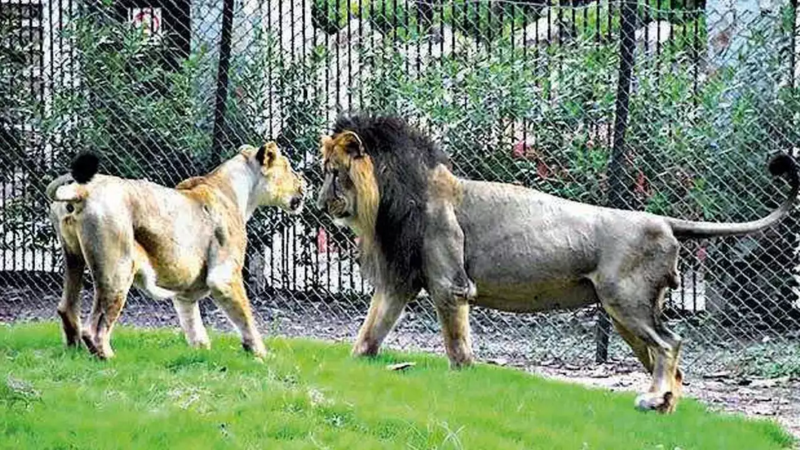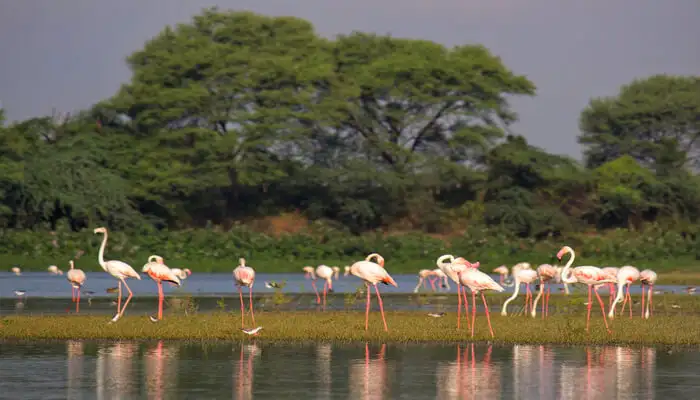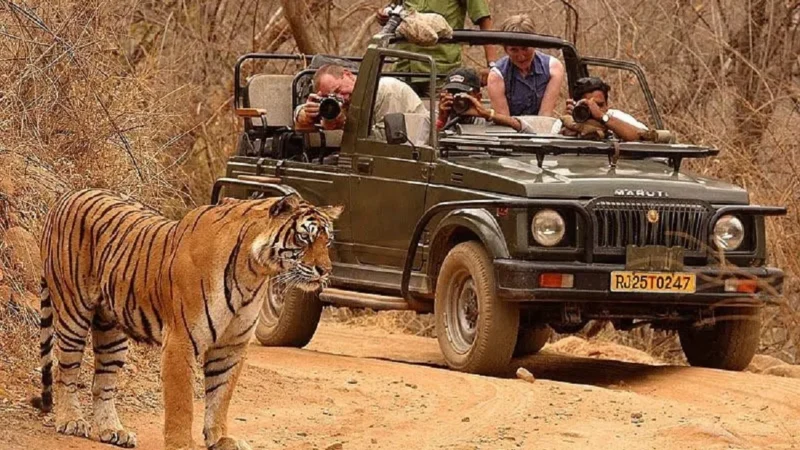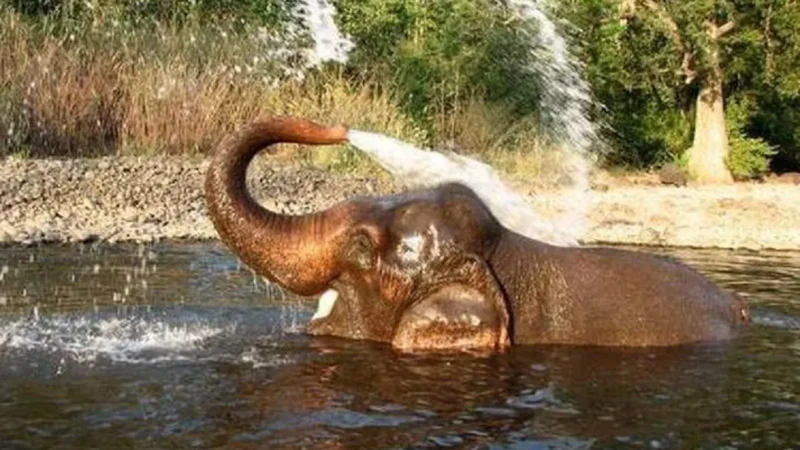Top 25 Famous Wildlife Sanctuary in Maharashtra
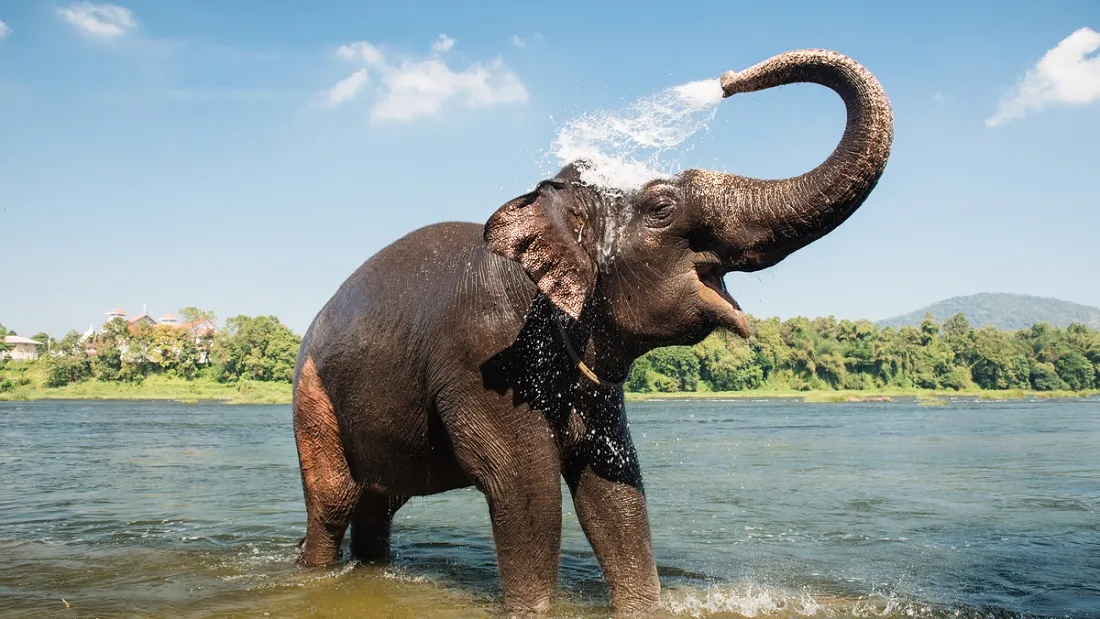
Table of Contents
ToggleMaharashtra Wildlife Sanctuary :
Maharashtra, a land of contrasts, where bustling cities meet serene wilderness, is not just about the dazzling lights of Mumbai or the heritage of Pune. It is also a realm where the untamed beauty of nature thrives, where the call of the wild echoes through dense forests and tranquil meadows. Nestled amidst the Western Ghats and dotted across its expansive landscape are Maharashtra’s famous wildlife sanctuaries – hidden gems that harbor some of India’s most diverse and endangered flora and fauna.
In this blog, we embark on a virtual journey to uncover the secrets of Maharashtra’s renowned wildlife sanctuaries. These protected havens are places to witness majestic creatures in their natural habitat and windows into the vibrant ecosystems that make up the state’s ecological tapestry. From the regal tigers of Tadoba Andhari Tiger Reserve to the enchanting birdlife of Bhigwan Bird Sanctuary, Maharashtra’s sanctuaries offer a kaleidoscope of natural wonders.
Wildlife Sanctuary of Maharashtra :
1- Tadoba Andhari Tiger Reserve
Tadoba Andhari Tiger Reserve is a tiger reserve located in the Chandrapur district of Maharashtra. It is one of the largest tiger reserves in India and is home to various other wildlife, including leopards, sloth bears, and elephants.
The reserve was established in 1955 and covers an area of 625.4 square kilometers. It is named after the Tadoba National Park and the Andhari Wildlife Sanctuary, merged to form the reserve in 1995.
Tadoba Andhari Tiger Reserve is home to a healthy population of tigers, with an estimated 80 tigers in the reserve. The reserve is also home to various other wildlife, including leopards, sloth bears, elephants, chital, sambar, gaur, and many species of birds.
The reserve is a popular tourist destination for wildlife viewing. Several safari options are available, including jeep safaris, elephant safaris, and boat safaris.
The best time to visit Tadoba Andhari Tiger Reserve is during the dry season, from October to April. During this time, the animals are more active and easier to spot.
Here are some of the things you can see and do in Tadoba Andhari Tiger Reserve:
- Go on a safari to see tigers, leopards, and other wildlife.
- Hike or trek through the forest.
- Visit the Tadoba National Park Visitor Center.
- Learn about the history and ecology of the reserve.
Tadoba Andhari Tiger Reserve is a beautiful and important wildlife sanctuary. It is a great place to learn about tigers and other wildlife, and to experience the beauty of the Indian forest.
2- Pench Tiger Reserve
Here is some information about Pench Tiger Reserve in Maharashtra, India:
- Pench Tiger Reserve is a tiger reserve located in the Nagpur district of Maharashtra. It is one of India’s most famous tiger reserves, and is home to a healthy population of tigers and a variety of other wildlife.
- The reserve was established in 1973 and covers an area of 757.18 square kilometers. It is named after the Pench River, which flows through the reserve.
- Pench Tiger Reserve is home to an estimated 60 tigers, leopards, sloth bears, elephants, chital, sambar, gaur, and many species of birds.
- The reserve is a popular tourist destination for wildlife viewing. Several safari options are available, including jeep safaris, elephant safaris, and boat safaris.
- The best time to visit Pench Tiger Reserve is during the dry season, from October to April. During this time, the animals are more active and easier to spot.
Here are some of the things you can see and do in Pench Tiger Reserve:
- Go on a safari to see tigers, leopards, and other wildlife.
- Hike or trek through the forest.
- Visit the Pench National Park Visitor Center.
- Learn about the history and ecology of the reserve.
Pench Tiger Reserve is a beautiful and important wildlife sanctuary. It is a great place to learn about tigers and other wildlife, and to experience the beauty of the Indian forest.
3- Melghat Tiger Reserve
Here is some information about Melghat Tiger Reserve in Maharashtra, India:
- Melghat Tiger Reserve (MTR) is located in the Amravati district of Maharashtra. It is one of the largest tiger reserves in India, and is famous for its population of tigers.
- The reserve was established in 1974 and covers an area of 1677 square kilometers. It is named after the Melghat Hills, located in the reserve.
- MTR is home to an estimated 100 tigers, leopards, sloth bears, elephants, chital, sambar, gaur, and many species of birds.
- The reserve is a popular tourist destination for wildlife viewing. Several safari options are available, including jeep safaris, elephant safaris, and boat safaris.
- The best time to visit Melghat Tiger Reserve is during the dry season, from October to April. During this time, the animals are more active and easier to spot.
Here are some of the things you can see and do in Melghat Tiger Reserve:
- Go on a safari to see tigers, leopards, and other wildlife.
- Hike or trek through the forest.
- Visit the Melghat Tiger Reserve Visitor Center.
- Learn about the history and ecology of the reserve.
4- Sahyadri Tiger Reserve
Sahyadri Tiger Reserve is located in the Sahyadri Ranges of the Western Ghats in Maharashtra, India. It is part of the ecoregions of North Western Ghats moist deciduous forests and North Western Ghats montane rain forests. These ranges form a common boundary between Maharashtra, Karnataka and Goa, and constitute rich evergreen, semi-evergreen and moist deciduous forests.
The reserve was established in 2008 and covers an area of 1,166 square kilometers. It is home to various wildlife, including tigers, leopards, bears, gaurs, sambars, wild boars, and many species of birds.
The reserve is a popular tourist destination for wildlife viewing. Several safari options are available, including jeep safaris, elephant safaris, and boat safaris.
The best time to visit the Sahyadri Tiger Reserve is during the dry season, from October to April. During this time, the animals are more active and easier to spot.
5- Bhimashankar Wildlife Sanctuary
Here are some information about Bhimashankar Wildlife Sanctuary in Maharashtra, India:
- Bhimashankar Wildlife Sanctuary is located in the Ambegaon and Khed talukas of Pune district, in the Western Indian state of Maharashtra. It was created in the 1980s to protect the habitat of the Indian Giant Squirrel.
- The sanctuary covers an area of 131 square kilometers and is a part of the Western Ghats (Sahyadri Ranges), which itself is recognised as one of the 12 biodiversity hotspots of the world.
- The sanctuary is home to a variety of wildlife, including:
- Indian Giant Squirrel (the state animal of Maharashtra)
- Leopard
- Sambar deer
- Wild boar
- Sloth bear
- Gaur
- Chital
- Nilgai
- Many species of birds
The sanctuary is a popular tourist destination for wildlife viewing, trekking, and camping.
The best time to visit the Bhimashankar Wildlife Sanctuary is during the dry season, from October to April. During this time, the animals are more active and easier to spot.
6- Radhanagari Wildlife Sanctuary
Radhanagari Wildlife Sanctuary is located in the Sindhudurg district of Maharashtra, India. It is a part of the Sahyadri Ranges of the Western Ghats, a UNESCO World Heritage Site. The sanctuary was established in 1958 and covers an area of 351.2 square kilometers.
The sanctuary is home to a variety of wildlife, including:
- Indian bison (gaur)
- Leopard
- Sambar deer
- Wild boar
- Sloth bear
- Gaur
- Chital
- Nilgai
- Many species of birds
The sanctuary is a popular tourist destination for wildlife viewing, trekking, and camping.
The best time to visit the Radhanagari Wildlife Sanctuary is during the dry season, from October to April. During this time, the animals are more active and easier to spot.
7- Chandoli National Park
Here is some information about Chandoli National Park in Maharashtra, India:
- Chandoli National Park is located in the Sangli and Satara districts of Maharashtra. It was established in 1985 and covers an area of 317.67 square kilometers.
- The park is a part of the Sahyadri Ranges of the Western Ghats, which is a UNESCO World Heritage Site.
- The park is home to a variety of wildlife, including:
- Tiger
- Leopard
- Indian bison
- Leopard cat
- Sloth bear
- Giant squirrel
- Sambar deer
- Chital
- Wild boar
- Many species of birds
- The park is a popular tourist destination for wildlife viewing, trekking, and camping.
- The best time to visit the Chandoli National Park is during the dry season, from October to April. During this time, the animals are more active and easier to spot.
Here are some of the things you can see and do in Chandoli National Park:
- Go on a safari to see the tiger, leopard, and other wildlife.
- Hike or trek through the forest.
- Visit the Chandoli Dam, a popular tourist destination.
- Learn about the history and ecology of the park.
The Chandoli National Park is a beautiful and important wildlife sanctuary. It is a great place to learn about wildlife and experience Western Ghats’ beauty.
8- Sanjay Gandhi National Park
Here is some information about Sanjay Gandhi National Park in Maharashtra, India:
- Sanjay Gandhi National Park is located in the Borivali, Thane district of Maharashtra. It is also known as Borivali National Park.
- The park was established in 1969 and covers an area of 87.5 square kilometers.
- The park is home to a variety of wildlife, including:
- Leopard
- Sambhar deer
- Spotted deer
- Wild boar
- Nilgai
- Chinkara
- Civet
- Porcupine
- Monitor lizard
- Many species of birds
- The park is a popular tourist destination for wildlife viewing, trekking, and camping.
- The best time to visit the Sanjay Gandhi National Park is during the dry season, from October to April. During this time, the animals are more active and easier to spot.
Here are some of the things you can see and do in Sanjay Gandhi National Park:
- Go on a safari to see the leopard, sambhar deer, and other wildlife
- Hike or trek through the forest.
- Visit the Kanheri Caves, a group of 109 caves dating back to the 1st century BCE.
- Learn about the history and ecology of the park.
- The Sanjay Gandhi National Park is a beautiful and important wildlife sanctuary. It is a great place to learn about wildlife and experience Western Ghats’ beauty.
- The entry fee for Sanjay Gandhi National Park is INR 60 for adults and INR 30 for children. The park is open from 6am to 6pm.
9- Nagzira Wildlife Sanctuary
Here is some information about Nagzira Wildlife Sanctuary in Maharashtra, India:
- Nagzira Wildlife Sanctuary is located in the Tirora, Arjuni (Sadak) & Goregaon Tahsils of Gondia District and Sakoli, Bhandara, Lakhni Tahsil of Bhandara district. The closest National Highway is NH-53.
- The sanctuary was established in 1970 and covers an area of 152.8 km².
- The sanctuary is home to a variety of wildlife, including:
- Tigers
- Leopards
- Sloth bears
- Gaur
- Sambar deer
- Chital
- Nilgai
- Wild boar
- Four-horned antelope
- Indian pangolin
- Many species of birds
- The sanctuary is a popular tourist destination for wildlife viewing, trekking, and camping.
- The best time to visit the Nagzira Wildlife Sanctuary is during the dry season, from October to April. During this time, the animals are more active and easier to spot.
Here are some of the things you can see and do in Nagzira Wildlife Sanctuary:
- Go on a safari to see the tigers, leopards, and other wildlife.
- Hike or trek through the forest.
- Visit the Nagzira Lake, a popular tourist destination.
- Learn about the history and ecology of the sanctuary.
The Nagzira Wildlife Sanctuary is beautiful and important. It is a great place to learn about wildlife and to experience the beauty of the Indian forest.
10- Navegaon National Park
Navegaon National Park is located in the Arjuni Morgaon subdivision of Gondia district in Maharashtra, India. The park is a part of the Satpura and Vindhya mountain ranges. It was established in 1975 and covers an area of 133.9 km².
The park is home to a variety of wildlife, including:
- Tigers
- Leopards
- Sloth bears
- Gaur
- Sambar deer
- Chital
- Nilgai
- Wild boar
- Four-horned antelope
- Indian pangolin
- Many species of birds
The park is a popular tourist destination for wildlife viewing, trekking, and camping. The best time to visit the park is during the dry season, from October to April.
Here are some of the things you can see and do in Navegaon National Park:
- Go on a safari to see the tigers, leopards, and other wildlife.
- Hike or trek through the forest.
- Visit the Navegaon Lake, a popular tourist destination.
- Learn about the history and ecology of the park.
The Navegaon National Park is a beautiful and important wildlife sanctuary. It is a great place to learn about wildlife and to experience the beauty of the Indian forest.
11- Bor Wildlife Sanctuary
Here is some information about Bor Wildlife Sanctuary in Maharashtra, India:
- Bor Wildlife Sanctuary is located in the Wardha district of Maharashtra. It was declared as a tiger reserve in July 2014.
- It is the smallest tiger reserve of India by area. The drainage basin of the nearby located Bor Dam falls within the reserve area.
- The sanctuary covers an area of 138.12 km².
- It is home to a variety of wildlife, including:
- Tigers
- Leopards
- Sloth bears
- Gaur
- Sambar deer
- Chital
- Nilgai
- Wild boar
- Four-horned antelope
- Indian pangolin
- Many species of birds
The sanctuary is a popular tourist destination for wildlife viewing, trekking, and camping. The best time to visit the sanctuary is during the dry season, from October to April.
Here are some of the things you can see and do in Bor Wildlife Sanctuary:
- Go on a safari to see the tigers, leopards, and other wildlife.
- Hike or trek through the forest.
- Visit the Bor Dam, a popular tourist destination.
- Learn about the history and ecology of the sanctuary.
The Bor Wildlife Sanctuary is beautiful and important. It is a great place to learn about wildlife and to experience the beauty of the Indian forest.
12- Phansad Wildlife Sanctuary
Here is some information about Phansad Wildlife Sanctuary in Maharashtra, India:
- Phansad Wildlife Sanctuary is a wildlife sanctuary in the Murud and Roha talukas of Raigad district, Maharashtra state, India. It was created in 1986 to preserve some of the coastal woodland ecosystem of the Western Ghats and consists of 6,979 ha of forest, grasslands and wetlands.
- The sanctuary is home to a variety of wildlife, including:
- Leopard
- Indian giant squirrel
- Sambar deer
- Wild boar
- Barking deer
- Bonnet Macaque
- Wild dog
- Malabar giant squirrel
- Many species of birds
- The sanctuary is a popular tourist destination for wildlife viewing, trekking, and camping.
- The best time to visit the sanctuary is during the dry season, from October to April. During this time, the animals are more active and easier to spot.
Here are some of the things you can see and do in Phansad Wildlife Sanctuary:
- Go on a safari to see the leopard, Indian giant squirrel, and other wildlife.
- Hike or trek through the forest.
- Visit the Phansad Fort, a 17th-century fort.
- Learn about the history and ecology of the sanctuary.
The entry fee for Phansad Wildlife Sanctuary is INR 30 for adults and INR 15 for children. The sanctuary is open from 6am to 6pm
13- Great Indian Bustard Sanctuary (Nannaj)
Here is some information about the Great Indian Bustard Sanctuary (Nannaj) in Maharashtra, India:
- The Great Indian Bustard Sanctuary (Nannaj) is a wildlife sanctuary located in the Solapur district of Maharashtra. It was established in 1979 to protect the endangered great Indian bustard (Ardeotis nigriceps).
- The sanctuary covers an area of 1,222 km². It is a semi-arid region with a mix of scrub forest, grassland, and agricultural land.
- The sanctuary is home to a variety of wildlife, including:
- Great Indian bustard
- Blackbuck
- Chinkara
- Wild boar
- Wolf
- Striped hyena
- Indian gazelle
- Many species of birds
- The sanctuary is a popular tourist destination for wildlife viewing, bird watching, and photography.
The best time to visit the sanctuary is during the dry season, from October to April. During this time, the animals are more active and easier to spot.
Here are some of the things you can see and do in the Great Indian Bustard Sanctuary (Nannaj):
- Go on a safari to see the great Indian bustard, blackbuck, and other wildlife.
- Go bird watching to see the many bird species living in the sanctuary.
- Take a hike or trek through the forest.
- Visit the Nanaj Fort, a 17th-century fort.
- Learn about the history and ecology of the sanctuary.
14- Mayureshwar Wildlife Sanctuary
Mayureshwar Wildlife Sanctuary is located in Baramati Tehsil in Pune district in Maharashtra, India. It is 74 km from Pune and 35 km from Daund. The sanctuary is one of the smallest wildlife sanctuaries in Maharashtra, with an area of only 5.14 km².
The sanctuary is named after Mayureshwar Temple, a Shiva temple located in the sanctuary. The sanctuary is famous for its population of chinkaras, or Indian gazelles. Other animals found in the sanctuary include leopards, striped hyenas, Indian foxes, and many species of birds.
The best time to visit the Mayureshwar Wildlife Sanctuary is during the dry season, from October to April. During this time, the animals are more active and easier to spot.
Here are some of the things you can see and do in Mayureshwar Wildlife Sanctuary:
- Go on a safari to see the chinkaras and other wildlife.
- Hike or trek through the forest.
- Visit the Mayureshwar Temple.
- Learn about the history and ecology of the sanctuary.
The entry fee for Mayureshwar Wildlife Sanctuary is INR 50 for adults and INR 25 for children. The sanctuary is open from 6am to 6pm.
15- Bhigwan Bird Sanctuary
Bhigwan Bird Sanctuary is located in the Pune district of Maharashtra, India. It is a 600-hectare (1,500-acre) sanctuary established in 1985 to protect the migratory birds in the area during the winter.
The sanctuary is home to over 230 species of birds, including flamingos, pelicans, egrets, herons, cormorants, storks, ducks, geese, and several species of warblers and sparrows.
The best time to visit the Bhigwan Bird Sanctuary is during the winter, from November to February. This is when the most migratory birds are present in the sanctuary.
Here are some of the things you can see and do in Bhigwan Bird Sanctuary:
- Go on a boat ride to see the flamingos and other birds.
- Go bird watching to see the many bird species living in the sanctuary.
- Take a hike or trek through the forest.
- Visit the Bhigwan Dam, a popular tourist destination.
- Learn about the history and ecology of the sanctuary.
16- Tansa Wildlife Sanctuary
Tansa Wildlife Sanctuary is located in the Shahapur and Bhiwandi talukas of Thane district and Wada taluka of Palghar district, Maharashtra, India. It is spread over an area of 320 square kilometers.
The sanctuary was established in 1986 to protect the catchment area of Tansa, Vaitarna and Modak Sagar lakes which are major source of water to the Mumbai, Thane and Bhiwandi cities.
The sanctuary is home to a variety of wildlife, including:
- Leopard
- Sambar deer
- Wild boar
- Sloth bear
- Four-horned antelope
- Indian pangolin
- Many species of birds
The best time to visit the Tansa Wildlife Sanctuary is during the dry season, from October to April. During this time, the animals are more active and easier to spot.
17- Painganga Wildlife Sanctuary
Painganga Wildlife Sanctuary is located in Umarkhed Tehsil of Yavatmal district of the Indian state of Maharashtra. It derives its name from the river Painganga or Penganaga River, which borders the sanctuary on its three sides. It encompasses a sprawling area of about 325 square kilometres and hosts various flora and fauna.
The sanctuary is home to a variety of wildlife, including:
- Leopard
- Chinkara
- Blackbuck
- Nilgai
- Sambar
- Four-horned antelope
- Wild boar
- Indian pangolin
- Many species of birds
The best time to visit the Painganga Wildlife Sanctuary is during the dry season, from October to April. During this time, the animals are more active and easier to spot.
18- Koyana Sanctuary
Koyna Wildlife Sanctuary is located in the Satara district of the Indian state of Maharashtra. It is spread over an area of 423.55 square kilometers.
The sanctuary was established in 1985 to protect the catchment area of the Koyna Dam, a major water source for the city of Pune.
The sanctuary is home to a variety of wildlife, including:
- Leopard
- Indian bison
- Sambar deer
- Four-horned antelope
- Sloth bear
- Indian pangolin
- Many species of birds
The best time to visit the Koyna Wildlife Sanctuary is during the dry season, from October to April. During this time, the animals are more active and easier to spot.
19- Katepurna Wildlife Sanctuary
Katepurna Wildlife Sanctuary is located in Akola district of Maharashtra, India. It is spread over an area of 152.8 square kilometers.
The sanctuary was established in 1970 to protect the four-horned antelope, which is an endangered species.
The sanctuary is home to a variety of wildlife, including:
- Four-horned antelope
- Barking dee
- Wild boar
- Nilgai
- Jungle cat
- Porcupine
The best time to visit the Katepurna Wildlife Sanctuary is during the dry season, from October to April. During this time, the animals are more active and easier to spot.
20- Thane Creek Flamingo Sanctuary
The Thane Creek Flamingo Sanctuary is a Ramsar site in the Thane Creek, an inlet of the Arabian Sea in Maharashtra, India. It was declared a sanctuary in 2015 and is home to various wildlife, including flamingos, pelicans, egrets, herons, cormorants, storks, ducks, geese, and several species of warblers and sparrows.
The best time to visit the Thane Creek Flamingo Sanctuary is during the winter, from November to February. This is when the most number of flamingos are present in the sanctuary.
Here are some of the things you can see and do in Thane Creek Flamingo Sanctuary:
- Go on a boat ride to see the flamingos and other birds.
- Go bird watching to see the many bird species living in the sanctuary.
- Take a hike or trek through the mangrove forest.
- Visit the Coastal and Marine Biodiversity Centre, which has a museum and an aquarium.
- Learn about the history and ecology of the sanctuary.
21- Dajipur Wildlife Sanctuary
Dajipur Wildlife Sanctuary is located in the Kolhapur district of Maharashtra, India. It is spread over an area of 650 square kilometers.
The sanctuary was established in 1956 to protect the Indian bison, which is an endangered species.
The sanctuary is home to a variety of wildlife, including:
- Indian bison
- Leopard
- Wild boar
- Sambar deer
- Chital
- Barking deer
- Sloth bear
- Many species of birds
The best time to visit the Dajipur Wildlife Sanctuary is during the dry season, from October to April. During this time, the animals are more active and easier to spot.
The sanctuary is also home to many waterfalls, which are a popular tourist destination.
22- Dnyanganga Wildlife Sanctuary
Dnyanganga Wildlife Sanctuary is located in the Buldhana district of Maharashtra, India. It is spread over an area of 205 square kilometers.
The sanctuary was established in 1975 to protect the wildlife of the area, which includes:
- Leopard
- Sloth bear
- Barking deer
- Wild boar
- Nilgai
- Spotted deer
- Hyena
The best time to visit the Dnyanganga Wildlife Sanctuary is during the dry season, from October to April. During this time, the animals are more active and easier to spot.
23- Nagzira Wildlife Sanctuary
Nagzira Wildlife Sanctuary is located in the Gondia district of Maharashtra, India. It is spread over an area of 152.8 square kilometers. The sanctuary is famous for its population of leopards.
The sanctuary is home to a variety of wildlife, including:
- Leopard
- Sloth bear
- Four-horned antelope
- Wild boar
- Nilgai
- Spotted deer
- Hyena
The best time to visit the Nagzira Wildlife Sanctuary is during the dry season, from October to April. During this time, the animals are more active and easier to spot.
24- Chaprala Wildlife Sanctuary
Chaprala Wildlife Sanctuary is located in the Chandrapur district of Maharashtra, India. It is spread over an area of 140 square kilometers. The sanctuary is famous for its population of tigers, leopards, and wild boars.
The sanctuary is home to a variety of wildlife, including:
- Tiger
- Leopard
- Wild boar
- Spotted deer
- Sambhar deer
- Sloth bear
- Jungle cat
- Many species of birds
The best time to visit the Chaprala Wildlife Sanctuary is during the dry season, from October to April. During this time, the animals are more active and easier to spot.
25- Malvan Marine Wildlife Sanctuary
The Malvan Marine Wildlife Sanctuary is located in the Sindhudurg district of Maharashtra, India. It is spread over an area of 29.22 square kilometers. The sanctuary is famous for its coral reefs and rich marine life.
The sanctuary is home to a variety of marine life, including:
- Coral reefs
- Sea anemones
- Mollusks
- Polychaetes
- Pearl oysters
- Fishes
The best time to visit the Malvan Marine Wildlife Sanctuary is during the monsoon season, from June to September. During this time, the water is clear and the visibility is good.
Here are some of the things you can see and do in Malvan Marine Wildlife Sanctuary:
- Go snorkeling or scuba diving to see the coral reefs and marine life.
- Go on a boat trip to explore the sanctuary.
- Learn about the ecology of the sanctuary at the Malvan Marine Biodiversity Centre.
The Malvan Marine Wildlife Sanctuary is a beautiful and important marine sanctuary. It is a great place to learn about marine life and to experience the beauty of the Indian coast.
Final Note:
As we conclude this remarkable journey, let us carry forward the spirit of conservation, the wonder of the wild, and the commitment to protect our planet’s natural wonders. Whether you’re inspired to plan your adventure amidst the pristine landscapes of Maharashtra’s sanctuaries or choose to support conservation efforts from afar, let the wild spirit of these sanctuaries stay alive within you.
In the heart of Maharashtra, where the forests whisper secrets and the rivers weave stories, where the call of the wild lingers, the famous wildlife sanctuaries are eternal reminders of the beauty and fragility of our planet’s ecosystems. They are not just sanctuaries; they are legacies, and their stories are etched in every footprint, every rustle of leaves, and every heartbeat that echoes through their hallowed grounds.

